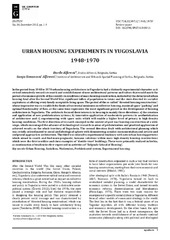Приказ основних података о документу
Urban housing experiments in Yugoslavia 1948-1970
| dc.creator | Alfirević, Đorđe | |
| dc.creator | Simonović Alfirević, Sanja | |
| dc.date.accessioned | 2018-12-26T10:58:54Z | |
| dc.date.available | 2018-12-26T10:58:54Z | |
| dc.date.issued | 2015 | |
| dc.identifier.issn | 1450-569X | |
| dc.identifier.uri | https://raumplan.iaus.ac.rs/handle/123456789/245 | |
| dc.description.abstract | In the period from 1948 to 1970 urban housing architecture in Yugoslavia had a distinctly experimental character as it strived intensively towards research and establishment of new architectural patterns and values that would mark the period of economic growth of the country. In conditions of mass housing construction, initiated by the devastated urban housing fund after the Second World War, significant influx of population to towns and the state directed its socialist aspirations at alloting every family acceptable living space. The period of the so-called " directed housing construction" , whose imperative was to establish the limits of existential minimum in collective housing, maximal space " packing" and optimal functionality of flats, at the same time represents the most significant period in the development of housing architecture in Yugoslavia. The architects focused their interests in housing in mainly three directions: a) the creation and application of new prefabrication systems, b) innovative application of modernistic patterns in aestheticization of architecture and c) experimenting with space units which will enable a higher level of privacy in high-density housing conditions. The first direction of research emerged in the context of post-war housing construction of a wide scope, which encouraged the advance of technological research in areas of prefabrication and practical application of achieved results on the whole territory of Yugoslavia. The second direction dealt with architectural planning which was strictly subordinated to social and ideological sphere with domineering socialist monumentalism and artistic and sculptural approach to architecture. The third was related to experimental tendency with new urban housing patterns which aimed to search and find more pragmatic, humane solutions within mass high-density housing constructions which were the first to utilize and show examples of " double-tract buildings. These were primarily realized in Serbia, as continuation of tendencies first expressed in activities of " Belgrade School of Housing". | en |
| dc.publisher | Institute of Architecture, Urban & Spatial Planning of Serbia | |
| dc.rights | openAccess | |
| dc.rights.uri | https://creativecommons.org/licenses/by-nc-nd/4.0/ | |
| dc.source | Spatium | |
| dc.subject | Experimental housing | en |
| dc.subject | Modernism | en |
| dc.subject | Prefabricated system | en |
| dc.subject | Socialism | en |
| dc.subject | Urban housing | en |
| dc.title | Urban housing experiments in Yugoslavia 1948-1970 | en |
| dc.type | article | |
| dc.rights.license | BY-NC-ND | |
| dcterms.abstract | Симоновић Aлфиревић, Сања; Aлфиревић, Ђорђе; | |
| dc.citation.volume | 1 | |
| dc.citation.issue | 34 | |
| dc.citation.spage | 1 | |
| dc.citation.epage | 9 | |
| dc.citation.other | 1(34): 1-9 | |
| dc.citation.rank | M24 | |
| dc.identifier.doi | 10.2298/SPAT1534001A | |
| dc.identifier.scopus | 2-s2.0-84957059830 | |
| dc.identifier.fulltext | https://raumplan.iaus.ac.rs//bitstream/id/1589/242.pdf | |
| dc.type.version | publishedVersion |

